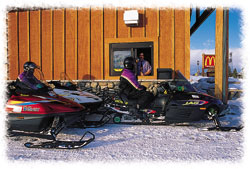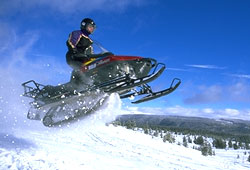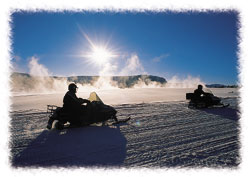![]() January-February 2000
January-February 2000
By Richard M. Romney
Photographs by Vince Heptig
 Spencer Evans traverses a winter wonderland. |
With the first snows of winter, the migration begins. From the mountain forests where they spend the summer, animals descend. Bison and elk meander toward broad, open meadows, seeking winter forage. Wolves, coyotes, and foxes follow, hoping to prey on the weary. Ravens fly low, eagles circle overhead, swans seek harbor at the islands in the river.
These animals aren't migrating south, however. They're heading for thermal heat. For centuries they have known the route to Yellowstone, a magic world where fire melts ice, where steam shoots high into the sky, and where magma-warmed earth provides relief from subzero blizzards that will soon sweep over the neighboring hills.
And all winter long, there's another migration to Yellowstone, too. This one is of people— naturalists and nature lovers, environmentalists and outfitters, snowshoers, cross-country skiers, and ... snowmobiling Boy Scouts and Venturers!
For nearly 30 years, the Great Salt Lake Council has organized snowmobile trips into Yellowstone National Park, the winter wonderland where two migrations—wildlife and human—meet. And the Scouts, like the wild animals, have learned that to adapt is to survive.
"Today, taking a snowmobile into the park is serious business," says Michael Seim, the guide who, on New Year's Day, is accompanying Venturers from Salt Lake City's Crew 2238 to Old Faithful geyser.
"If you are caught leaving the groomed roadway or speeding or driving recklessly, a ranger can ticket you, fine you, and eject you from the park," he warns.
Partly to avoid such complications, the Great Salt Lake Council requires all of its groups to attend two snowmobile safety briefings and be accompanied by a professional guide.
"A lot has changed over time," explains Bill Howell, an outfitter who's been renting to the council since 1974. "When the program started back in 1971, kids as young as 12 years old could legally drive a snowmobile, if they stayed within 50 yards of a supervising adult. Up until eight years ago, you could ride if you were 14."
Through the 1970s and 80s, three Utah councils sent as many as 600 riders through the park during the year-end holiday break from school. Local outfitters liked the extra business, and Scouts benefited from discount prices, not only on snowmobiles but on food and lodging as well.
Then the law in the park changed. "Now you're required to have a driver's license to use a snowmobile in the park," Howell explains. "It's much safer, and you don't have the younger kids who lack the physical stamina."
So snowmobiling inside Yellowstone is a privilege taken seriously. So are the lessons taught to the Venturers: respect for animals and preservation of the environment.
Crew member David Martin, who came on a similar trip last year, remembers reading a display that said: "In winter animals have no energy to spare. ... If you force an animal to flee, you may be dooming it to slow starvation. Try walking a few steps without snowshoes in thigh-deep snow. Now imagine the energy required to run through it."
 Brett Mortenson views bison from a distance. |
That was enough to get David thinking. "Bison are so awesome," he says. "Who wants to go home wondering if you spooked one and made it die?"
"We've learned about ways to reduce pollution, too," explains John Reschke, one of the adult leaders of the crew, which is chartered to the Little Cottonwood 20th Ward of the Church of Jesus Christ of Latter-day Saints.
"Simple things like shutting off your motor when you stop, rather than idling, can make a difference in both noise and emissions," he says.
Concern about the environment has prompted questions about permitting snowmobiles in the park. According to the Bozeman (Mont.) Daily Chronicle of Nov. 21, 1998, "The dispute revolves around what, if any, impact the machines have on the park and its wildlife, principally bison."
The U.S. Park Service recently settled a lawsuit with an animal rights group that could lead to limits on snowmobile travel in Yellowstone. Meanwhile, snowmobile manufacturers are rushing to develop new technology that may produce cleaner machines.
It's another time of adapting for Scouts, who have a role to play in showing that they can be courteous, obey speed limits, respect animals, and learn from nature while in the park.
"Scouts need to remember to drive prudently," says park ranger Julie Hannaford. "They need to remember that, because we groom the roads and some animals will try to use them as an easier path than deep snow. So be cautious. They won't get out of your way.
 In town, the Venturers' snowmobiles pull up to the drive-through window at McDonald's. |
"And," the ranger adds, "Scouts as well as their leaders should be well experienced in environmental issues and resource protection. That's what our mission as rangers is. We're here to protect the resource, and we need their help in that."
"The reason Scouts come here is to see the park," says Matt Monroe, the Great Salt Lake Council district executive who has run the snowmobiling program for the past three years.
"They could go snowmobiling closer to home and still have a great time," he says. "But here they can learn to appreciate the national park. They can see how the wildlife survives, witness the thermal activity, and enjoy the scenic views. That's a completely different experience in the winter, and snowmobiling is secondary to that."
But snowmobiling is a big part of the fun for teen-agers, and many units add a day for some extra snowmobile-driving before entering the national park. Monroe welcomes this, because it allows Scouts to fully experience snowmobiling, then focus on the park itself while they are visiting it.
One of the favorite "outside" trips is to head west, then south of Island Park, Idaho, up the mountain trails to the summit of Two Top Peak. There you can look down east and west of the Continental Divide, where rows and rows of snow-flocked evergreens march on like soldiers in an arctic army.
 Nick Noel sits high in the saddle as he blasts off a mogul and catches air on a trail outside the park. |
Some Crew 2238 members took that trip and were well rewarded. "We came out right above the clouds," says Nick Noel. "It kept clearing and then the clouds kept coming back. You could see down into the valley, miles and miles of trees covered with snow. It looked like a totally different planet."
"There were clearings in the trees with some whoop-de-do's (moguls) to try and a few places to take safe jumps," says Tyler McGee. Then on the way back to the hotels in West Yellowstone, Mont., a closed-for-the-season airport provided a safe place to test the machines' velocity.
"It's worth all that work we put into our money-earning project so we could come here," Tyler says. (To earn money for the trip, the crew put up American flags on every state and national holiday for a year in the lawns of neighbors who paid a fee for the service.)
 Geothermal steam rises above the Gibbon Geyser Basin as the Venturers of Crew 2168 zoom toward their lodgings in West Yellowstone, Mont. |
"Most of us have been to Yellowstone in the summer," Kevin Maxwell says. "But in winter it's a different Yellowstone. I never felt like driving fast through the park, [because] the animals and the geysers were awesome! I just wanted to stop and see everything."
"There was no snow in Salt Lake City when we left to come up here," John Reschke notes. "But when we got up here it was a whole different world."
"Tons of snow," David Martin concludes. "And lots of nature."
Tons of snow. The wonder of nature. That's Snow Wonder. That's Yellowstone in winter, and it's no wonder why Scouts from Utah will keep coming north to see it and to learn from it for as long as they can.
Richard M. Romney also wrote the article "One of the Best" in the May-June 1999 Scouting. He lives in Salt Lake City.
Be Safe, Have FunSnowmobile safety is so important that the Great Salt Lake Council won't let Scouts ride in Yellowstone until they've had two safety briefings, one on the night they arrive and another the next morning just prior to using the machines. "A safe trip is a fun trip," says district executive Matt Monroe, who runs the snowmobile program for the council. "We talk about safety, and we talk about regulations specific to the park." Monroe offers these key safety tips:
Of course, if you're planning a cross-country trip, there are some additional things to consider, like packing extra clothing, food, and fuel and, again, letting people know your route and expected time of return. Just remember, snowmobiles are fun and easy to operate, but they can also be dangerous. The best safety tip of all is simply to use common sense! |
Visiting the First National ParkNational parks were a new idea in 1872, when President Ulysses S. Grant signed the law preserving Yellowstone National Park as a 2.2-million-acre sanctuary. It was not just the first national park in the United States. It was the first in the world!
Many other parks have been created since, but Yellowstone is still considered one of the most impressive and most visited. About three million people come through the park each year, 500,000 of those during winter. Winter brings many changes. Geothermal features, such as geysers and mud pots, remain the same, though they generate a lot of visible steam that gives them a mystical air when surrounded by snow. Snow also makes it more difficult for wildlife to get around, and so they try to adapt. "The animals that aren't quite so shy will use the groomed roads a lot," says park ranger Julie Hannaford. "Coyotes are adaptable, so they tend to use the roadways. The bison as well, and the elk. Other animals, like wolves, are much more secretive, so they don't use the roads too often." To survive Yellowstone's harsh winters, animals must conserve energy and spend most of their time searching for food. That means many animals will walk on groomed roadways because it is easier than walking through deep snow. So snowmobilers must be wary. "We're glad to have Scouts come to the park," says ranger Hannaford. "They just need to be trained before they come to respect the animals and the environment and to follow the rules while they're here." |
Wise Ways to Watch WildlifeWatching animals in the wild is literally a matter of life and death. The following tips are specific to dealing with herds of bison in Yellowstone during the winter. But the principles should also be considered anytime you encounter untamed animals.
—R.R. |
Help for Winter VisitorsAlthough the Great Salt Lake Council is the most visible Scouting presence at Yellowstone during the winter, "there are units from other councils that come from time to time," says district executive Matt Monroe, who administers the council's program. For help in planning a winter trip to Yellowstone, call him at the council service center, (801) 582-3663. Information is also available from the West Yellowstone Chamber of Commerce, (406) 646-7701; or from the Visitors Services Office, P.O. Box 168, Yellowstone National Park, WY 82190, (307) 344-2107. |
| The Boy Scouts of America | http://www.scouting.org |